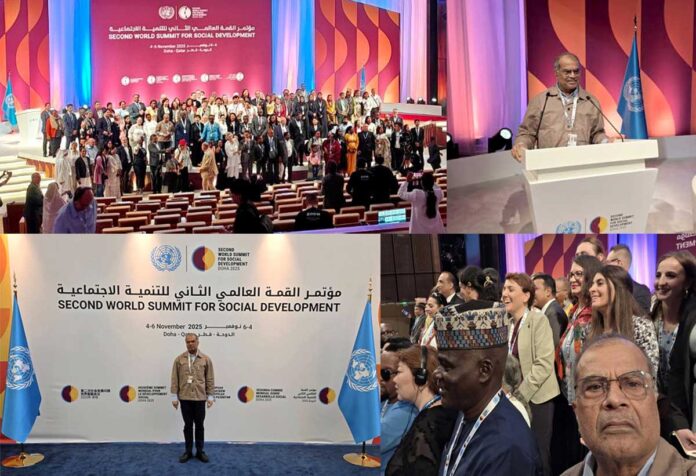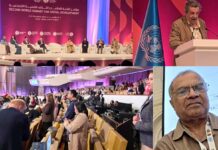2nd UN World Social Summit concluded with a commitment toward social protection.
Today is the last day of the UN Second World Social Summit (WSSD2). WSSD2 expressed commitment toward Universal Social Protection. I have participated in concluding session of civil society forum, I have given some photos in here.
Participated in different sessions especially on social protection (in our country we say it as “Safety Net “or social security.). I tried to explain some issues related to introduction on Toward Universal Social Protection issue, in future I will request my friends / collogues to study on the issue and if possible, try to develop campaign in positive engagement with political forces. At present our government spends around 19 to 23 % budget in safety net programs.
As it has stated in one ESCAP publication universal social protection (USP) define “USP refers to unconditional income transfers that protect the financial security of every individual, when they require it during key life cycle and labor market contingencies”. When consider these as floor then there are broad four component, i.e., health (health services, maternity), Children (Childhood), Working -age adults (sickness, unemployment, maternity, disability, workplace injury) and Older persons (old age, survivorship). In bracket I tried to address the life cycle contingencies. Here I do like to state some principles in this regard,
1. The individual, not the household, is defined as the primary rights holder and beneficiary of social protection.
2. Eligibility criteria must be simple and objective and designed to verify the experience of a life cycle or labor market contingency.
3. Income transfer should seek primarily to prevent poverty by addressing common risks, thereby reducing the need for reactive, last -resort transfers.
4. Basic income transfers designed to address life cycle must be unconditional.
There are four stages in means – testing versus universality from Least Inclusive to Most Inclusive, these are Poverty Targeted ( only those observed and classified as poorest receiving benefit), Affluence tested ( all but those in the highest wealth / income groups receive benefit), Benefit tested ( only those who do not qualify for social insurance receive benefit, can form part of universal benefit system when carefully combined with contributory benefits) and Universal ( everyone experiencing lifecycle contingency receives benefit, regardless of means.)
সামাজিক সুরক্ষার প্রতি অঙ্গীকার : আজ জাতিসংঘের দ্বিতীয় বিশ্ব সামাজিক শীর্ষ সম্মেলনের (WSSD2) শেষ দিন।
WSSD2 সার্বজনীন সামাজিক সুরক্ষার প্রতি অঙ্গীকার ব্যক্ত করেছে। আমি সিভিল সোসাইটি ফোরামের সমাপনী অধিবেশনে অংশ নিয়েছি এবং এখানে কিছু ছবি দিয়েছি। আমি বিভিন্ন অধিবেশনে, বিশেষ করে সামাজিক সুরক্ষা (যা আমাদের দেশে আমরা “সেফটি নেট” বা সামাজিক নিরাপত্তা বলে থাকি) নিয়ে আয়োজিত সেশনগুলোতে অংশ নিয়েছি। সার্বজনীন সামাজিক সুরক্ষার প্রবর্তনের সাথে সম্পর্কিত কিছু বিষয় ব্যাখ্যা করার চেষ্টা করেছি। ভবিষ্যতে আমি আমার বন্ধু/সহকর্মীদের কাছে এই বিষয়টি নিয়ে অধ্যয়ন করার জন্য এবং সম্ভব হলে রাজনৈতিক শক্তিগুলোর সাথে ইতিবাচক অংশগ্রহণের মাধ্যমে একটি প্রচারণা (campaign) গড়ে তোলার জন্য অনুরোধ করব। বর্তমানে আমাদের সরকার সেফটি নেট কর্মসূচিতে বাজেটের প্রায় ১৯ থেকে ২৩ শতাংশ ব্যয় করে।
এসক্যাপ (ESCAP)-এর একটি প্রকাশনায় বলা হয়েছে, সার্বজনীন সামাজিক সুরক্ষা (Universal Social Protection – USP) এর সংজ্ঞা হলো: “ইউএসপি (USP) বলতে নিঃশর্ত আয় স্থানান্তরকে বোঝায় যা প্রত্যেক ব্যক্তির আর্থিক নিরাপত্তা রক্ষা করে যখন জীবনের প্রধান চক্র এবং শ্রমবাজারের আকস্মিক পরিস্থিতিতে তাদের প্রয়োজন হয়।” যখন এগুলোকে একটি মেঝে (floor) হিসাবে বিবেচনা করা হয়, তখন এর বিস্তৃত চারটি উপাদান রয়েছে, যেমন: স্বাস্থ্য (স্বাস্থ্য পরিষেবা, মাতৃত্ব), শিশু (শৈশব), কর্মক্ষম-বয়সের প্রাপ্তবয়স্ক (অসুস্থতা, বেকারত্ব, মাতৃত্ব, অক্ষমতা, কর্মক্ষেত্রে আঘাত) এবং বয়স্ক ব্যক্তি (বার্ধক্য, উত্তরাধিকার/সার্ভাইভশীপ)। বন্ধনীর মধ্যে আমি জীবনের চক্রের আকস্মিক পরিস্থিতিগুলি উল্লেখ করার চেষ্টা করেছি। আমি এই বিষয়ে কিছু নীতি তুলে ধরতে চাই:
১. সামাজিক সুরক্ষার প্রাথমিক অধিকারভোগী এবং সুবিধাভোগী হিসেবে পরিবার নয়, ব্যক্তিকে সংজ্ঞায়িত করা হয়।
২. যোগ্যতার মানদণ্ড সরল ও বস্তুনিষ্ঠ হতে হবে এবং তা জীবন চক্র বা শ্রমবাজারের আকস্মিক পরিস্থিতির অভিজ্ঞতা যাচাই করার জন্য তৈরি করতে হবে।
৩. আয় স্থানান্তরের মাধ্যমে প্রাথমিকভাবে সাধারণ ঝুঁকিগুলির মোকাবিলা করে দারিদ্র্য প্রতিরোধে সচেষ্ট হতে হবে, এর ফলে শেষ আশ্রয় হিসেবে reactive স্থানান্তরের প্রয়োজনীয়তা হ্রাস পাবে।
৪. জীবনচক্রের মোকাবিলা করার জন্য তৈরি মৌলিক আয় স্থানান্তরগুলি নিঃশর্ত হতে হবে।
Means-testing বনাম সার্বজনীনতা-এর চারটি স্তর রয়েছে, যা কম অন্তর্ভুক্তিমূলক (Least Inclusive) থেকে সবচেয়ে বেশি অন্তর্ভুক্তিমূলক (Most Inclusive) পর্যন্ত বিন্যস্ত:
দারিদ্র্য-কেন্দ্রিক (Poverty Targeted): শুধুমাত্র যারা দরিদ্রতম হিসাবে পর্যবেক্ষণ ও শ্রেণীবদ্ধ হন, তারাই সুবিধা পান।
স্বচ্ছলতা-পরীক্ষিত (Affluence tested): সর্বোচ্চ ধনী/উচ্চ আয়ের গোষ্ঠীর সবাই বাদে অন্য সবাই সুবিধা পান।
সুবিধা-পরীক্ষিত (Benefit tested): শুধুমাত্র যারা সামাজিক বীমার জন্য যোগ্য নন, তারাই সুবিধা পান (যখন অবদান-ভিত্তিক সুবিধার সাথে সাবধানে একত্রিত করা হয়, তখন এটি সার্বজনীন সুবিধা ব্যবস্থার অংশ হতে পারে)।
সার্বজনীন (Universal): জীবনচক্রের আকস্মিক পরিস্থিতির সম্মুখীন হওয়া প্রত্যেকে, আর্থিক অবস্থা নির্বিশেষে, সুবিধা পান।
Newslink
 |
 |
 |
 |
 |





